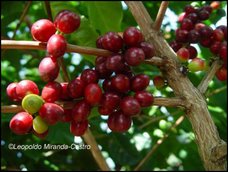 You may wonder why I’m writing about coffee and the Chesapeake Bay when coffee is not even grown in the Chesapeake area. Well, I can tell you that there are many reasons. Some that you may know and others you may not. First of all, I love coffee, everything from growing it in my native Puerto Rico to roasting it here in the Chesapeake watershed. Although this is a very personal and important to me it is not why I want to talk to you about the relationship of coffee with the Chesapeake Bay.
You may wonder why I’m writing about coffee and the Chesapeake Bay when coffee is not even grown in the Chesapeake area. Well, I can tell you that there are many reasons. Some that you may know and others you may not. First of all, I love coffee, everything from growing it in my native Puerto Rico to roasting it here in the Chesapeake watershed. Although this is a very personal and important to me it is not why I want to talk to you about the relationship of coffee with the Chesapeake Bay.I know that many of you are coffee lovers. We Americans consume over 2.5 billion lbs of coffee every year but, did you know that coffee beans, for the universally popular drink, are cultivated in more than 80 tropical countries around the World? And, with over $150 billion in annual retail sales and providing employment for more than 100 million people, coffee’s economic value is second only to petroleum. In addition, more than 124 million acres are currently cultivated with coffee in the most biologically-diverse tropical lands of the world.
There are two basic types of coffee plantations, namely shade-grown and sun-grown coffee. In shade-grown plantations, coffee plants grow under the shading canopy of larger trees. Most shading trees are native species commonly found in surrounding natural forests, providing important habitat for wildlife, protecting the delicate tropical soils and water resources. On the other hand, “sun coffee” plantations are a monoculture of coffee trees where, in order to increase production, the natural shading canopy of trees is eliminated exposing the coffee plants to full sun light. These plantations do not support native forest trees and wildlife species as traditional shaded coffee plantations do. In addition, since these monocultures can’t take advantage of the natural ecosystems they require higher inputs of fertilizers and pesticides affecting even more the delicate tropical ecosystems. The bottom line is that with shade coffee plantations you have nature working with you and with sun coffee you are working against Mother Nature.
Many of the birds that inhabit these shade grown coffee habitats are our own Chesapeake birds that migrate and winter in the tropics. Yes, many of our birds expend on average between 5 and 7 months every year, foraging and living in coffee plantations in South and Central America and the Caribbean. For example, the Black-throated Blue Warbler, Red-eye Vireo, Gray Catbird, and our beloved Baltimore Oriole, just to mention a few, all winter in tropical habitats including shaded coffee plantations. If these habitats are degraded or eliminated, our Chesapeake birds may stop singing.
We can help keep our birds singing by buying shade-grown coffee. Ask your local retailers to carry shade-grown coffees from the wintering habitats of our Chesapeake birds. Now look out of your window or go to your favorite birding spot and enjoy a fresh cup of shade-grown coffee. When you hear the birds singing at you they may be saying thank you!



1 comment:
Who knows where to download XRumer 5.0 Palladium?
Help, please. All recommend this program to effectively advertise on the Internet, this is the best program!
Post a Comment